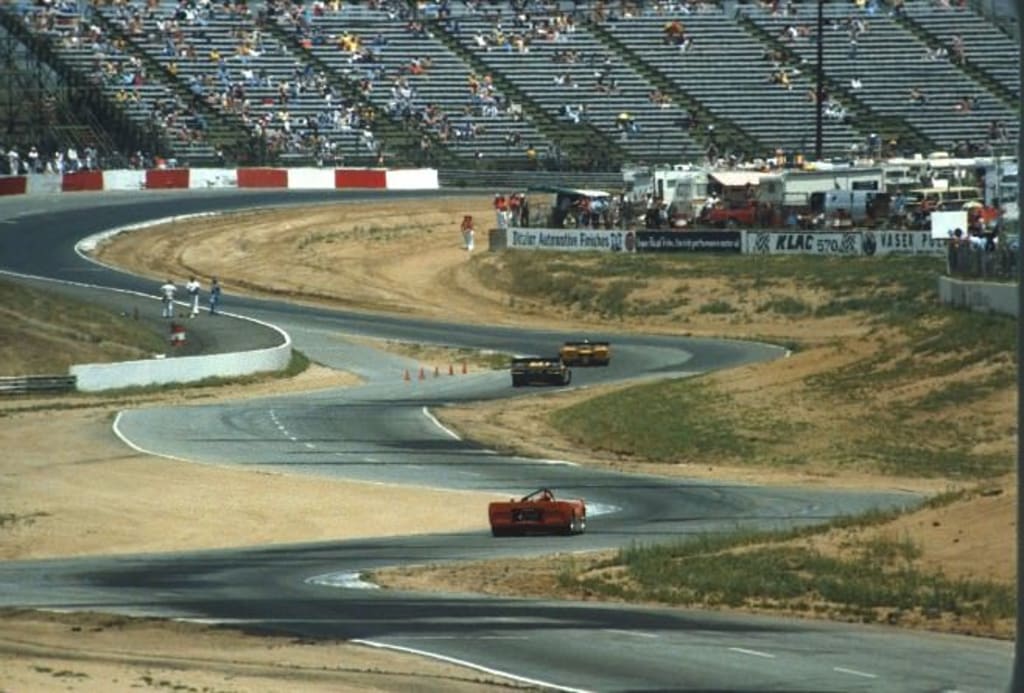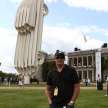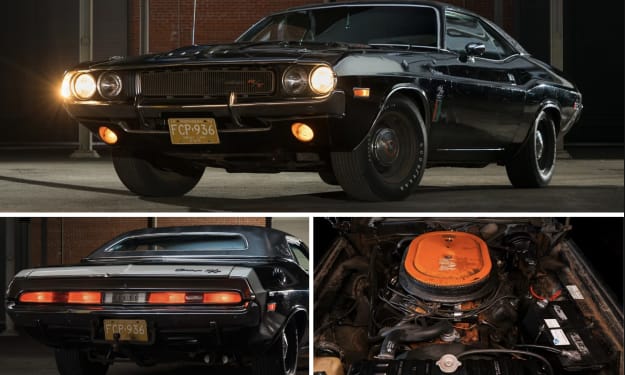Riverside International Speedway
The End of an Era and the Rise of Retail Ruins

The Riverside International Speedway was synonymous with the thrilling cacophony of roaring engines, the unmistakable screech of tires gripping the asphalt, and the heart-pounding sensation of speed that left spectators and racers alike breathless. For many years, these electrifying sounds painted an auditory masterpiece that resonated throughout the Riverside International Speedway. Located in California's vibrant core, this racetrack was not merely a playground for those with a need for speed. It stood as an iconic landmark, a living tribute to a time when American road racing was in its glorious prime, drawing enthusiasts from all corners of the nation.
Yet, as the adage goes, even the most magnificent things must face the inevitability of time. The Riverside International Speedway, with its rich history and countless memories, witnessed its own twilight. In an unexpected turn of events, the ground that once echoed with the symphony of high-octane races and cheering crowds was earmarked for a new vision - a sprawling shopping mall meant to be the next hub of activity and commerce. The promise was grand; a modern-day agora where families and individuals would converge for shopping, entertainment, and more. However, just as the speedway had its trials and tribulations, the mall too grappled with a rapidly changing retail landscape. The challenges of evolving consumer behaviors, the rise of digital commerce, and shifting economic tides meant that the bustling mall that was once envisioned now stands eerily quiet, a shadow of its intended glory, mirroring the nostalgic end of the speedway it replaced.
The Glory Days of Riverside International Speedway
who lived and breathed the thrill of the race. Over the years, it showcased a diverse range of racing spectacles, from the adrenaline-pumping NASCAR events to the sophisticated sports car championships. The asphalt of Riverside bore witness to the prowess of racing titans. Legends such as Dan Gurney, with his unparalleled skill, Mario Andretti, known for his fearless driving, and Richard Petty, the king of speed, all left their mark here. Their feats, their rivalries, and their moments of triumph became integral chapters in the speedway's storied legacy.
What set the Riverside International Speedway apart from other tracks was its distinctive design and character. It wasn't just about speed; it was about mastering the art of racing. With its long stretches that allowed drivers to push their machines to the limit and its intricate turns that tested their precision and control, the track was both a challenge and a dream for every racer. Securing a victory at Riverside wasn't just about crossing the finish line first; it was a testament to a driver's skill, strategy, and sheer determination. For the legions of fans who flocked to its stands, Riverside was more than just a venue to watch races. It was a theater of dreams, an arena where they could immerse themselves in the drama, the excitement, and the passion of racing. Every race was a story, every lap a memory, and every victory a legend in the making. The Riverside International Speedway wasn't just a place; it was an emotion, an unforgettable chapter in the annals of racing history.
The Turn of the Tide
As time marched forward, the once magnetic charm of the Riverside International Speedway started to diminish. The world of racing was evolving, and with it came the emergence of state-of-the-art tracks equipped with the latest technology and amenities. These new tracks, with their modern allure, began to overshadow the classic beauty of Riverside. The racing industry itself was undergoing significant transformations, with changes in sponsorship, broadcasting rights, and the preferences of a new generation of fans. As a result, Riverside, with its rich history, found itself grappling with the challenges of staying relevant in this rapidly changing landscape. The echoing cheers of the crowd became softer, the grandstands less packed, and the vibrant energy that once permeated every race began to fade. The wear and tear on the track, once a testament to its storied past, now stood as a symbol of its declining prominence.
By the time the late 1980s rolled around, the writing was on the wall. A pivotal decision was reached, signaling the conclusion of Riverside's legendary chapter in racing history. The land, which had once reverberated with the roar of engines and the cheers of passionate fans, was earmarked for a new purpose: the construction of a vast shopping mall. This transition, from a historic racetrack to a symbol of commercialism, was met with a mix of disbelief and sorrow by many. To them, it wasn't just the closing of a venue; it was the loss of a sanctuary where memories had been forged, where heroes had been celebrated, and where the spirit of racing had thrived for decades. The impending transformation felt like a poignant farewell to a bygone era, a time when the Riverside International Speedway stood as a beacon of racing excellence.
The Mall That Wasn't Meant to Be
In the place where the iconic Riverside International Speedway once stood, the Moreno Valley Mall emerged, symbolizing a new era of commerce and community engagement. Designed with grand ambitions, this mall was heralded as the next big retail destination, aiming to transform the locale into a bustling hub of activity. Developers and planners had high hopes, imagining families, tourists, and shoppers flocking to the mall, drawn by its diverse offerings and modern amenities. And indeed, for a period, the Moreno Valley Mall lived up to its promise. It wasn't just a shopping center; it was a vibrant community space. From high-end boutiques to local artisan shops, from gourmet restaurants to cozy cafes, and from cinemas to children's play areas, the mall seemed to have something for everyone. It became a place where people gathered, socialized, and created memories.
Yet, the world of retail was on the brink of a revolution. The dawn of the digital age brought with it the meteoric rise of e-commerce platforms, offering consumers the convenience of shopping from the comfort of their homes. This shift, coupled with evolving consumer behaviors and preferences, posed significant challenges for traditional brick-and-mortar establishments like the Moreno Valley Mall. One by one, stores that had once thrived began to close their doors, unable to compete with the allure of online shopping. The footfalls that once echoed through the mall's corridors grew sparse, and the vibrant atmosphere began to wane. The spaces that were once filled with laughter, chatter, and the hum of activity now lay vacant, casting long shadows and amplifying the silence. In its current state, the Moreno Valley Mall serves as a poignant reflection of the ever-changing nature of commerce and society. Where there was once the promise of endless possibilities, there now stands a monument to adaptability, resilience, and the relentless march of time.
A Legacy Remembered
The Riverside International Speedway, though no longer standing tall in its original grandeur, has left an indelible mark on the hearts and minds of countless individuals. Those who had the privilege of experiencing its heyday, whether as racers or spectators, carry with them vivid memories of adrenaline-packed races, the roar of engines, and the sheer excitement that permeated the air. They recall the legends who raced there, leaving behind tales of unmatched skill and unparalleled passion. While the physical structure of the speedway has been replaced by the urban sprawl of concrete structures and commercial establishments, the essence of what it stood for — passion, competition, and the pursuit of excellence — remains unshaken.
The Moreno Valley Mall, in its current state of near-desolation, serves as a powerful reflection on the fleeting nature of success and the cyclical patterns of growth and decline. Once envisioned as a bustling center of commerce, it now stands relatively silent, its vast corridors echoing the changes in consumer behavior and the challenges of brick-and-mortar establishments in the digital age. Yet, beyond its current state, the mall emphasizes a deeper message — the significance of valuing our past, of holding onto the stories and experiences that shape our collective identity. It's a stark reminder that while businesses and landscapes may evolve, the memories and lessons they impart remain invaluable.
In the grand tapestry of history, the tales of the Riverside International Speedway and the Moreno Valley Mall intertwine, painting a picture of ambition, change, and resilience. Their stories, though distinct, converge on themes of transformation and the inevitable passage of time. For many who have witnessed their respective rises and declines, these tales serve as poignant reminders of life's ephemerality. They underscore the value of cherishing moments, celebrating achievements, and most importantly, recognizing that while physical structures may fade, the stories they house and the emotions they evoke will forever remain etched in our hearts.
About the Creator
Dean Kirkland
Dean Kirkland, seasoned director & cinematographer. With a passion for cars & visual storytelling, Dean's work resonates, leaving a lasting impact. Dive into a world where every frame tells a story.
Enjoyed the story? Support the Creator.
Subscribe for free to receive all their stories in your feed. You could also pledge your support or give them a one-off tip, letting them know you appreciate their work.






Comments (1)
Great work! This is fantastic!